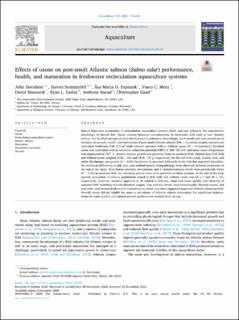| dc.description.abstract | Steroid hormones accumulate in recirculation aquaculture systems (RAS) and may influence the reproductive physiology of farmed fish. Ozone reduces hormone concentrations in freshwater RAS used to rear Atlantic salmon, but its effect on reproductive development is unknown. Accordingly, an 8-month trial was carried out to evaluate the growth, health, and maturation of post-smolt Atlantic salmon (296 ± 4 g initial weight) reared in six replicated freshwater RAS (9.5 m3 total volume) operated with or without ozone (N = 3/treatment). Residual ozone was controlled with an oxidation reduction potential (ORP) of 300–320 mV, and mean water temperature was maintained at 14.7 °C. Atlantic salmon growth was generally faster in ozonated RAS. Salmon from RAS with and without ozone weighed 2156 ± 101 and 1810 ± 15 g, respectively, by the end of the study. Caudal, anal, and pelvic fin damage was greater (P < 0.05) for salmon in ozonated RAS early in the trial but improved thereafter. No statistical differences in gill, skin, and skeletal muscle histopathology were observed between treatments at the end of the study. Waterborne estradiol, testosterone, and 11-ketotestosterone levels were periodically lower (P < 0.05) in ozonated RAS, but maturing salmon were more prevalent in these systems. At the end of the trial, percent maturation of salmon populations reared in RAS with and without ozone was 63 ± 7 and 48 ± 1%, respectively; however, maturity appeared to be related to fish size. Improved water quality was observed in ozonated RAS including reduced dissolved copper, iron, and zinc levels, total heterotrophic bacteria counts, and true color, and increased ultraviolet transmittance, which may have supported improved Atlantic salmon growth. Overall, ozone did not inhibit the onset or prevalence of Atlantic salmon maturation, but significant improvements in water quality and salmon growth performance resulted from its use. | |
